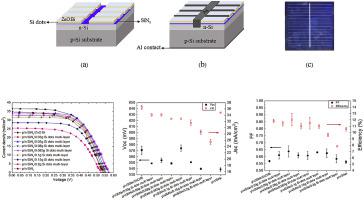Progress in Natural Science: Materials International ( IF 4.7 ) Pub Date : 2021-02-10 , DOI: 10.1016/j.pnsc.2020.11.008 Thipwan Fangsuwannarak , Supanut Laohawiroj , Peerawoot Rattanawichai , Kamonchanok Mekmork , Warakorn Limsiri , Rungrueang Phatthanakun

|
In this work, silicon ink composing of silicon powder and zinc oxide solution was formulated and spin-coated on quartz and n/p-Si substrates followed by drying the films under atmosphere at the temperature of 550 °C. The results showed that this top-addition layer could be the highly promising layer for photo-generating carriers in third-generation photovoltaics to enhance blue-light absorption. X-ray diffraction and scanning electron microscopy techniques were used to study the presence of silicon and zinc oxide nano-crystallites. The thin films consisting of different energy bandgap of Si nanocrystals (~100 nm) with narrow bandgap and spherical ZnO:Bi nanocrystal (~20 nm) with wider bandgap could be obtained from the evidence of bandgap enlargement. The band gaps of the thin films were tunable by adjusting silicon dots density in ZnO:Bi film. Energy upshift of light absorption edge depended on the silicon dots density was observed in the range 1.6–3.3 eV related band gap enlargement by Tauc plot. Under illumination, a high photocurrent gain of the thin film comprised of low Si dots density coated on a quartz substrate was about 103 times higher compared with its dark current. This result is agreeably explained in terms of its lower superficial trap states at the interface between silicon and zinc oxide matrix. The composite layer can be applied to a third-generation solar cell with the efficiency 1.50% higher than that with a typical crystalline-Si solar cell.
中文翻译:

通过旋涂沉积的硅点膜作为第三代光伏产品的载流子附加层
在这项工作中,配制了由硅粉和氧化锌溶液组成的硅墨水,并将其旋涂在石英和n / p-Si基板上,然后在550°C的温度下在大气中干燥薄膜。结果表明,该顶部添加层可能是用于第三代光伏电池中光生载流子以增强蓝光吸收的极有希望的层。X射线衍射和扫描电子显微镜技术用于研究硅和氧化锌纳米微晶的存在。可以从带隙扩大的证据中获得由窄带隙的Si纳米晶体(〜100 nm)和带隙较宽的球形ZnO:Bi纳米晶体(〜20 nm)的不同能带隙组成的薄膜。可以通过调节ZnO:Bi膜中的硅点密度来调节薄膜的带隙。通过Tauc曲线在1.6–3.3 eV相关的带隙扩大范围内观察到光吸收边缘的能量上移取决于硅点密度。在照明下,由低Si点密度覆盖在石英基板上的薄膜构成的高光电流增益约为10是暗电流的3倍。关于其在硅和氧化锌基质之间的界面处较低的表面陷阱态,可以令人满意地解释该结果。该复合层可以以比典型的晶体硅太阳能电池高1.50%的效率应用于第三代太阳能电池。

























 京公网安备 11010802027423号
京公网安备 11010802027423号